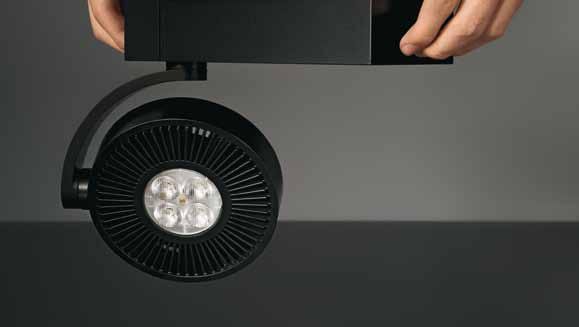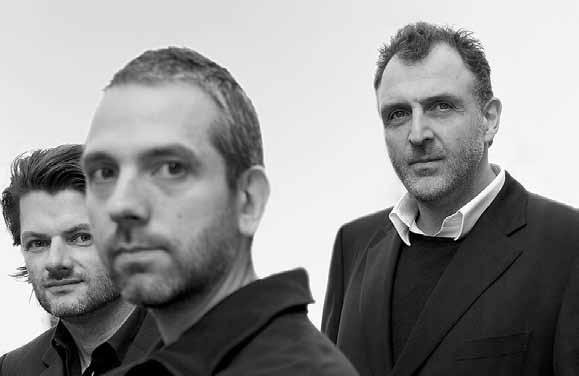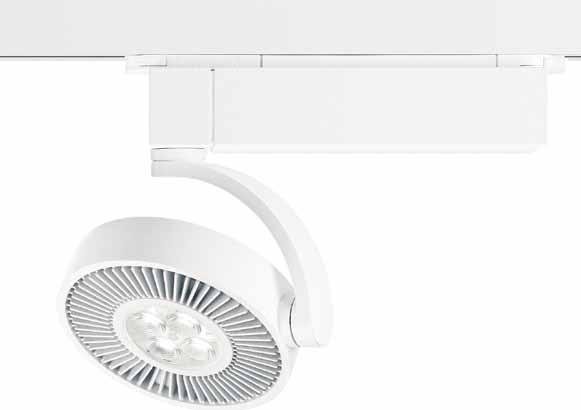The new spotlight series Discus is based on an expressive design that manages for the first time to integrate the capabilities as well as the requirements of LED technology. The unmistakable shape reflects our familiar perception of the sun: a disc with radially arranged rays, in this case the blades of a passive cooling attachment, ensuring a long service life of the central high-performance LED module. With only 28 mm, the LED design is extremely flat. The new, compact, unobtrusive design of the track box adaptor conforms to the minimalist nature of this spotlight design. The spotlight series won the iF product design award 2010.
The design of this exceptional spotlight series was developed by EOOS - a Viennese design studio and long-standing partner of Zumtobel. Highly successful products such as the LED spotlight Tempura, the spotlight series Vivo or the first eco-design spotlight Liviano illustrate what these masters of innovation based in the Austrian capital excel in - succinct yet unobtrusive design. Their self-declared philosophy of Poetical Analysis® essentially means that the design process is preceded by an exploration of the corporate philosophy of the partner, in an effort to understand the subconscious identity of the client, and hence to achieve a perfect balance of functional and emotional components. Poetical Analysis® primarily involves the search for an intuitive image, a ritual, a story or a myth.
Interview with Harald Gründl, Gernot Bohmann and Martin Bergmann, responsible for creativity at the design company EOOS.
The spotlight series Discus emerged after a consideration of the new possibilities of designing with LED technology. What challenges did you face during the development process?
Harald Gründl: The idea of developing a really flat spotlight goes back four years to the briefing for our first LED spotlight (Tempura). The advances in LED technology and the greatly increased efficiency of LEDs, have finally made it possible for us to realise our vision of developing a simple disc-shaped LED spotlight. This confirms our conviction that a technological change is really taking place - that the LED can actually meet the future requirements of lighting quality and energy efficiency. So far, LED technology has been integrated in conventional constructional shapes. During the development process we soon realised that we would do this the other way round and integrate conventional illuminants in this disc shape.
The 'sun rays' in the Discus design are very distinctive - are you very fond of unmistakeable shapes?
Harald Gründl: We were looking for a powerful image to base the Discus design on. We found this very powerful image of sun discs on pendants worn by shamans. These sun disc images are thousands of years old. In our eyes this archaic and very symbolic shape in combination with modern high technology, is a perfect reflection of today's society in our eyes:
as human beings we are influenced by stories, myths and rituals that have existed for thousands of years. But on the other hand, we are also very much influenced by modern technology, which we are not always able to understand fully. The combination of these differing aspects really represented the starting point of the design of Discus for us.
The rays fulfil an important technical function - is the design intended to explicitly underline this?
Harald Gründl: The radial arrangement that you see in Discus calls to mind the symbolic shape of the shaman pendant. In addition to that, the radially arranged blades are cooling fins that help to cool the LED module in the centre of the spotlight. The design of the spotlight ensures that whatever position the spotlight is in, air is sucked in from below, cooling of the LEDs is guaranteed and the hot air is given off to the back. This is an excellent demonstration of our design concept: symbolic shapes should not only stand for themselves alone, but be an integral part of a technical function. We don't consider design to be something that is added to a technical function. The shape that finally emerges is an interaction of a symbolic shape and technical necessity.
LED technology has resulted in an increase in the importance of the technical requirements of the illuminant, also for the designer- how do you handle that? Do you have to also be a light technology expert now?
Harald Gründl: Although we are talking about a spotlight here, the problem that had to be solved in this case was not based on light technology, but on heat technology. This also illustrates the changed approach to LED technology: it's more a matter of how to get rid of the heat rather than a consideration of light technology aspects. The LED module is as such already optimised from a light technology point of view. It really only needs to be cooled effectively. This means that instead of wrapping up and packaging, in future, design will have to break open shapes to be able to meet the technical requirements of the LED. We hope that this strong archetypal shape of the spotlight will remain, only to be supplemented by ever more efficient LEDs.
The spotlight series Discus is especially suitable for sales and presentation applications- what do you consider to be the major advantages of the spotlight?
Harald Gründl: Our experience as retail designers has shown that it is very important to have a structural design with varying illuminants. So there shouldn't be any different sizes, only variations in light - the angle of radiation or the illuminant. This has two advantages: hopefully only discs will be around in a few years, and, for the current application in the retail sector, various illuminants can still be combined with each other without having to fit different types of spotlights to the ceiling.




